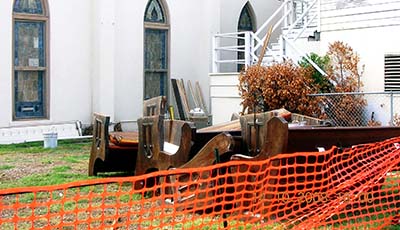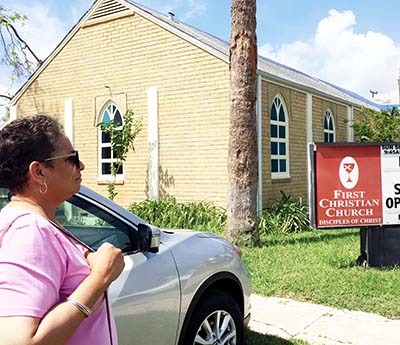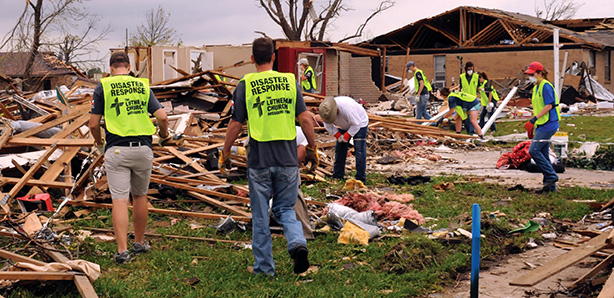In August of 2017, the city of Houston braced itself for a hurricane named Harvey making its way toward landfall. Houstonians are no strangers to major storm systems, but none expected Harvey to cause the damage it did. The storm stalled over the city for three days and dumped over 50 inches of rain on the metro area – enough water to fill the Astrodome three times over and to depress the Earth’s crust across the region by half an inch. Houstonians were stranded in their homes and neighborhoods, and the National Guard and the Red Cross were unable to bring outside resources into many areas for over a week. After the water receded, the city faced the monumental task of rebuilding homes (over 208,000 were destroyed) and public infrastructure. As they so often do, faith communities rose to the challenge of the crisis and provided over $210 million in funds and over 525,000 hours of volunteer labor to the relief and recovery efforts. Countless congregations opened their doors to become shelters and host sites for volunteer teams, provided clean drinking water, food, and clothing, and became informal hubs for Houstonians to access assistance and information. They responded in ways that no one else could.

The congregants at Reedy Chapel, in Galveston, Texas, helped the island recover after several hurricanes and at least one fire. The Chapel suffered severe damage from Hurricane Ike in 2008 and its sanctuary was closed for 315 days for repairs and restoration.
Sharon Gillins, Reedy Chapel
Partners for Sacred Places has long championed the fact that houses of worship have public value – that the activities congregations support and host within their buildings are essential to the health and well being of their communities. Never is this more apparent than during a natural disaster, when churches, synagogues, mosques, and temples transform into emergency relief sites. They are the first places that people come for help, and the first to provide essential aid. Houses of worship participate in the long-term recovery effort, providing volunteer manual labor and ongoing assistance to their neighbors as communities rebuild. It is not hyperbolic to say that America cannot recover from natural disasters without congregations and the buildings that they steward. The preservation and maintenance of these buildings are therefore not only good public investments, but an essential component of climate resilience and disaster management strategies.
To look more closely at the value of historic buildings in disaster resilience, a research team was organized by the University of Texas at San Antonio’s Center for Cultural Sustainability, funded by the Texas Historical Commission. Partners’ staff joined an interdisciplinary team of building professionals to investigate the key factors influencing the resiliency of older sacred places along the Texas Gulf Coast. The project recruited nine case study congregations in Galveston, Harris, and Victoria counties, and the architects provided thorough assessments of their facilities to identify damage caused by previous storms that threatened their resilience in the face of future storms. Partners’ staff interviewed Gulf Coast congregations and relief organizations, and convened Knowledge Cafés to learn about how congregations and their buildings participate in an informal relief network after natural disasters. These conversations provided key information on how congregations can be resourced and supported in the fugure, and how congregations can best engage with civic groups to effectively collaborate in relief and recovery efforts.
The team’s research findings were incorporated into an accessible and easy-to-use toolkit for congregations to assess and increase their own readiness for future disasters, including:
- Resilience Roadmap: A step-by-step manual for building managers and congregational leaders to improve the resilience of their facilities and organizations before and after a natural disaster;
- Resilience Performance Indicators: An easy and free survey tool for property managers to predict how well their facilities will stand up to natural disasters;
- Summary Vulnerability Assessment: A more detailed assessment that can be used by congregations (collaborating with an architect) to identify and prioritize capital projects and identify strategies to holistically enhance resilience;
- Resilience Treatments & Strategies: A quick guide to the most effective recommendations for improving the structural resilience of sacred places.
As climate change creates more extreme weather events, houses of worship must become active and intentional partners in disaster recovery and resilience efforts. Following this research project, Partners and UTSA’s Center for Cultural Sustainability will continue to collaborate by building a resilience network of congregations, judicatories, disaster relief organizations, preservationists, and academic institutions. This network will work to increase local and national resilience to climate change and resulting natural disasters by strengthening congregations and their buildings to respond to the next big storm.
How Your Congregation Can Prepare for the Next Big Storm
Congregations can strengthen their presence and service most effectively by developing partnerships with the agencies and organizations that need physical space to provide relief and recovery services. If you have not already done so, begin conversations about what you can offer with:
- Your local Office of Emergency Management
- Your local Voluntary Organizations Active in Disaster (VOAD) chapter
- Faith-Based Disaster Relief GroupsLutheran Disaster Response
- NECHAMA – Jewish Response to Disaster
- Presbyterian Disaster Assistance
- United Methodist Committee On Relief (UMCOR)

Sacred places such as First Christian Church DOC in Aransas Pass, Texas, because of their sturdy construction, can weather storms and serve as local relief stations following disasters. They become distribution sites for food, water, and information about government-sponsored aid, contributing to a community’s resilience following a disaster.
First Christian Church

